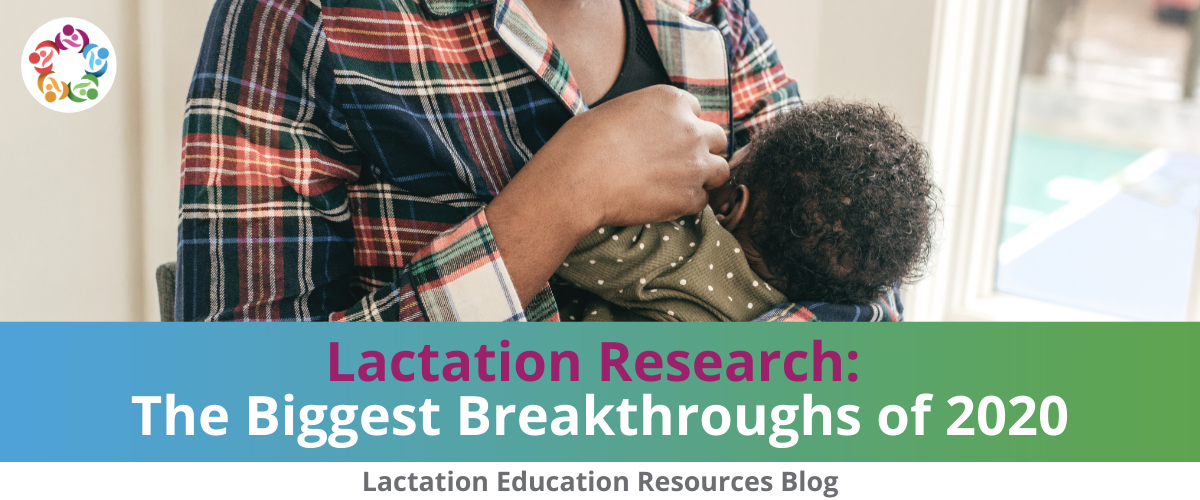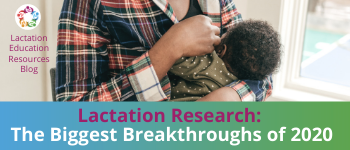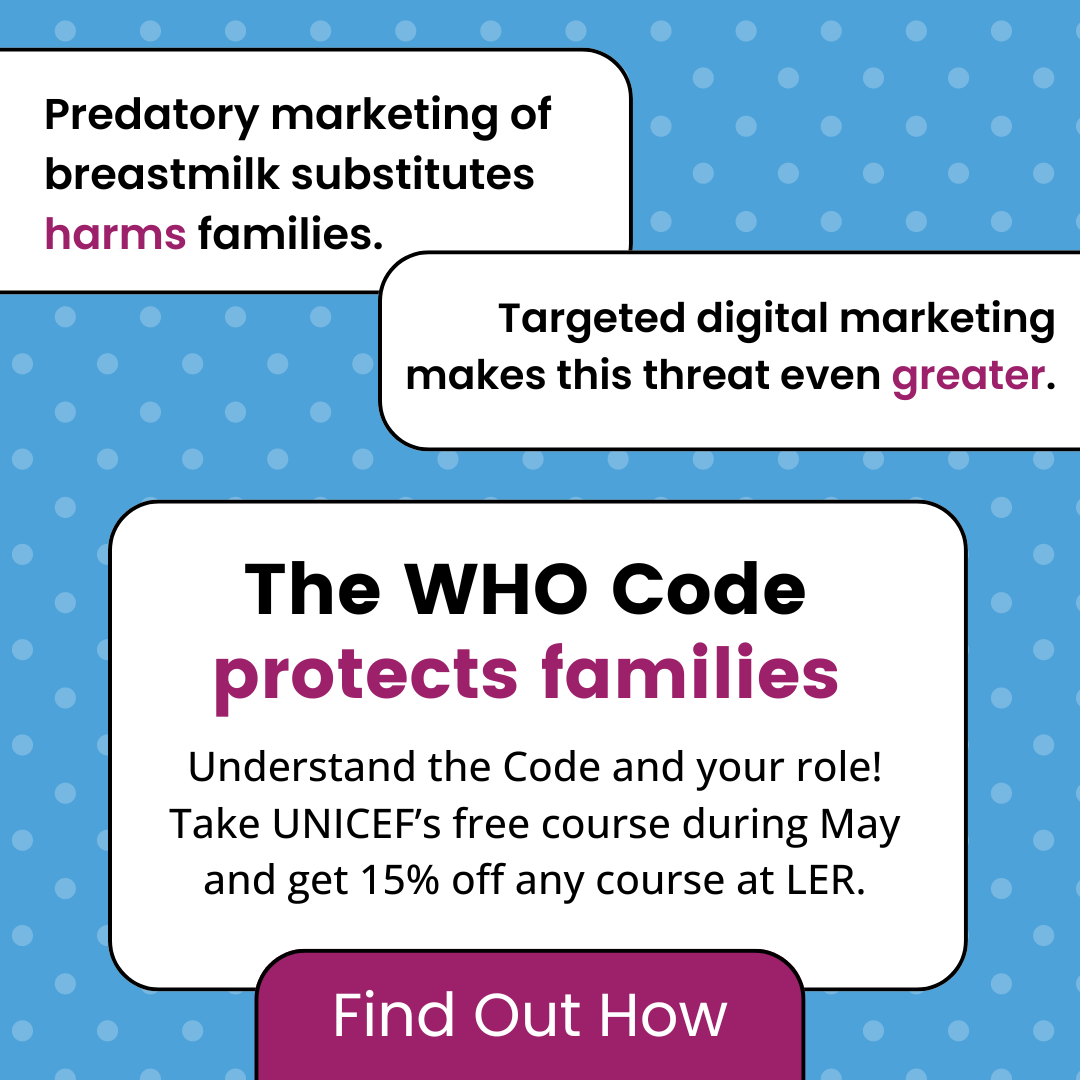Lactation Research: The Biggest Breakthroughs of 2020

As an IBCLC, you want to practice evidence-based care. But keeping up with the latest research can be overwhelming, even in a normal year.
And most of us would agree that 2020 was anything but normal.
What if an expert agreed to study the year’s worth of lactation literature for you and bring back the most interesting and useful information, all in one place?
An expert did. That’s the premise behind the Lactation Education Resources course Annual Update 2021.
Now you can learn about the most significant research done in 2020, explained and analyzed by a veteran lactation care provider with more than 20 years in the field.
In this clear, accessible course, Sekeita Lewis-Johnson, DNP, FNP-BC, IBCLC breaks down nearly 30 studies, protocols, and publications from 2020 into news you can use in your practice today.
Here are some of the highlights.
Human milk and Covid-19
A year into the pandemic, key studies shed light on two questions.
Does human milk from parents who are positive for Covid-19 pose a risk to their infants? And can human milk from parents who are Covid-19 positive actually confer protection?
Fox et al (2020) examined 15 milk samples from participants previously infected with Covid-19, three to four weeks after their symptoms resolved, looking for antibodies that would offer protection to infants—and found them.
“Human milk from Covid-19 positive donors exhibits significantly higher Secretory IgA reactivity against the receptor binding domain of the SARS-COV-2 binding site than pre-pandemic controls,” Lewis-Johnson notes.
“… [Its] role is to act locally on the newborn’s gut … as a first line of defense directed at foreign antigens. So that’s why this is great news—human milk is medicinal.”
A second study (Bertino et al, 2020) analyzed milk samples from 14 lactating parents in Italy diagnosed with Covid-19 and followed their newborns for the first month of life.
Eleven of the mothers were symptomatic at the time of milk collection, which was performed using specific hygiene protocols.
Thirteen of the 14 samples were negative for Covid-19 and one was positive. Four of the newborns tested positive within the first 48 hours of life. All had uneventful courses of infection and were negative by six weeks.
Based on their studies, the authors concluded that parents who are positive for Covid-19 do not expose their infants to additional risk of infection by breastfeeding.
Rethinking pacifiers?
One 2020 study suggests that pacifiers may be safer during breastfeeding than previously thought.
Hermanson & Astrand (2020) investigated whether recommendations given about pacifier use in the first two weeks of life impacted breastfeeding at six months.
The authors found no significant difference between parents who introduced pacifiers within four days of birth, between five and 14 days, after two weeks, or never when they measured breastfeeding rates at two, four, and six months.
Based on their results, the authors discourage blanket advice against early pacifier use and urge providers to opt for recommendations tailored to each family’s needs.
Nipple Shields—A Cautionary Note
Is a client who uses a nipple shield at risk for lowering milk supply?
A 2020 study suggests that caution about milk supply is warranted when a nipple shield is introduced.
Coentro et al (2020) asked parents to pump with an appropriately sized nipple shield, a too-small nipple shield, and no nipple shield at all. Pumping with an appropriately sized shield did in fact compromise milk removal—a full 25 percent less milk was removed than with no shield at all.
The authors stress the need to fully inform parents of the potential risk to their milk supply when introducing a nipple shield and provide close monitoring of supply and close follow up of parents discharged from the hospital using a shield.
Lactation After Loss
It’s a topic most people don’t want to think about—and that’s precisely the problem, according to a 2020 literature review, which found much room for improvement in the lactation information and support given to parents who suffer an infant death.
Dickens (2020) found evidence that the difficult emotions that lactation after loss can bring up are often not addressed with families, and that families often are not informed of the various lactation options open to them (suppressing lactation with or without pharmaceuticals, expressing milk for their own reasons, or donating milk, for example).
“I want you to ask yourself, how does your organization deal with this topic in practice?” Lewis-Johnson says. “[H]ow is this topic treated and how much attention is given to individuals who experience a perinatal loss? Are all options explored or even addressed? If not, this is an article that you most definitely want to read.”
Examining Equity
Several researchers tackled hard questions about equity in lactation care in 2020.
One Canadian study found that health care providers’ perceptions of parents’ race and ethnicity dramatically impacted the lactation information and support they gave, based on their assumptions about the parents’ attitudes and desires.
Studying a Chinese population, investigators interviewed public health workers about their interactions with parents.
Parents in the study who were racialized as Chinese by the workers were viewed as less likely to follow WHO or Canadian guidelines regarding breastfeeding, and half of the nurses interviewed said that they could accurately assume a family’s infant feeding preferences based solely on their last name.
The study also found that information given to families postpartum differed based on racialization. English-speaking families were given information on breastfeeding and community resources. Chinese-speaking families were given similar information, but were also given information on formula feeding.
Asked about this difference, nurses said it was simply “an effective use of their time.”
“This is … not just in Canada,” Lewis-Johnson says. “It happens in the United States and … it’s probably happening elsewhere also. These inequities are built into systemic practices and racism.”
Gray et al (2020), in their investigation into the influence of early lactation assistance on exclusive breastfeeding rates, discovered that White parents are more likely to receive an IBCLC visit in the hospital, while Hispanic parents were significantly less likely to be visited by an IBCLC.
The same study found that those with private insurance received significantly more help from IBCLCs than those without.
“There is so much to be said, but I’ll sum it up by saying, it’s time for folks to do the work,” Lewis-Johnson says. “The data is clear regarding bias in … lactation support … [Are] organizations truly working to correct disparate care? Not just by their … statements … but by the way equity is being operationalized?”
The above is just a sampling of the 2020 research, policy changes, protocols, and more covered in the Annual Update 2021. Take the complete course and expect to find more on new research into:
- NICU lactation care
- Hyperbilirubinemia
- New Academy for Breastfeeding Medicine protocols on oversupply, breast cancer, and the care of LGBTQQ+ families
- New guidance from the United Kingdom on lactation and anesthesia
- In-patient success rates for exclusive breastfeeding, and the important role of the IBCLC
- New research on lactation and the workplace
- Additional studies on Covid-19 and human milk
- A full bibliography so you can access the studies for yourself
- And much more!
Register for the course here.

Lactation Research: The Biggest Breakthroughs of 2020
As an IBCLC, you want to practice evidence-based care. But keeping up with the latest research can be overwhelming, even in a normal year.
And most of us would agree that 2020 was anything but normal.
What if an expert agreed to study the year’s worth of lactation literature for you and bring back the most interesting and useful information, all in one place?
An expert did. That’s the premise behind the Lactation Education Resources course Annual Update 2021.
Now you can learn about the most significant research done in 2020, explained and analyzed by a veteran lactation care provider with more than 20 years in the field.
In this clear, accessible course, Sekeita Lewis-Johnson, DNP, FNP-BC, IBCLC breaks down nearly 30 studies, protocols, and publications from 2020 into news you can use in your practice today.
Here are some of the highlights.
Human milk and Covid-19
A year into the pandemic, key studies shed light on two questions.
Does human milk from parents who are positive for Covid-19 pose a risk to their infants? And can human milk from parents who are Covid-19 positive actually confer protection?
Fox et al (2020) examined 15 milk samples from participants previously infected with Covid-19, three to four weeks after their symptoms resolved, looking for antibodies that would offer protection to infants—and found them.
“Human milk from Covid-19 positive donors exhibits significantly higher Secretory IgA reactivity against the receptor binding domain of the SARS-COV-2 binding site than pre-pandemic controls,” Lewis-Johnson notes.
“… [Its] role is to act locally on the newborn’s gut … as a first line of defense directed at foreign antigens. So that’s why this is great news—human milk is medicinal.”
A second study (Bertino et al, 2020) analyzed milk samples from 14 lactating parents in Italy diagnosed with Covid-19 and followed their newborns for the first month of life.
Eleven of the mothers were symptomatic at the time of milk collection, which was performed using specific hygiene protocols.
Thirteen of the 14 samples were negative for Covid-19 and one was positive. Four of the newborns tested positive within the first 48 hours of life. All had uneventful courses of infection and were negative by six weeks.
Based on their studies, the authors concluded that parents who are positive for Covid-19 do not expose their infants to additional risk of infection by breastfeeding.
Rethinking pacifiers?
One 2020 study suggests that pacifiers may be safer during breastfeeding than previously thought.
Hermanson & Astrand (2020) investigated whether recommendations given about pacifier use in the first two weeks of life impacted breastfeeding at six months.
The authors found no significant difference between parents who introduced pacifiers within four days of birth, between five and 14 days, after two weeks, or never when they measured breastfeeding rates at two, four, and six months.
Based on their results, the authors discourage blanket advice against early pacifier use and urge providers to opt for recommendations tailored to each family’s needs.
Nipple Shields—A Cautionary Note
Is a client who uses a nipple shield at risk for lowering milk supply?
A 2020 study suggests that caution about milk supply is warranted when a nipple shield is introduced.
Coentro et al (2020) asked parents to pump with an appropriately sized nipple shield, a too-small nipple shield, and no nipple shield at all. Pumping with an appropriately sized shield did in fact compromise milk removal—a full 25 percent less milk was removed than with no shield at all.
The authors stress the need to fully inform parents of the potential risk to their milk supply when introducing a nipple shield and provide close monitoring of supply and close follow up of parents discharged from the hospital using a shield.
Lactation After Loss
It’s a topic most people don’t want to think about—and that’s precisely the problem, according to a 2020 literature review, which found much room for improvement in the lactation information and support given to parents who suffer an infant death.
Dickens (2020) found evidence that the difficult emotions that lactation after loss can bring up are often not addressed with families, and that families often are not informed of the various lactation options open to them (suppressing lactation with or without pharmaceuticals, expressing milk for their own reasons, or donating milk, for example).
“I want you to ask yourself, how does your organization deal with this topic in practice?” Lewis-Johnson says. “[H]ow is this topic treated and how much attention is given to individuals who experience a perinatal loss? Are all options explored or even addressed? If not, this is an article that you most definitely want to read.”
Examining Equity
Several researchers tackled hard questions about equity in lactation care in 2020.
One Canadian study found that health care providers’ perceptions of parents’ race and ethnicity dramatically impacted the lactation information and support they gave, based on their assumptions about the parents’ attitudes and desires.
Studying a Chinese population, investigators interviewed public health workers about their interactions with parents.
Parents in the study who were racialized as Chinese by the workers were viewed as less likely to follow WHO or Canadian guidelines regarding breastfeeding, and half of the nurses interviewed said that they could accurately assume a family’s infant feeding preferences based solely on their last name.
The study also found that information given to families postpartum differed based on racialization. English-speaking families were given information on breastfeeding and community resources. Chinese-speaking families were given similar information, but were also given information on formula feeding.
Asked about this difference, nurses said it was simply “an effective use of their time.”
“This is … not just in Canada,” Lewis-Johnson says. “It happens in the United States and … it’s probably happening elsewhere also. These inequities are built into systemic practices and racism.”
Gray et al (2020), in their investigation into the influence of early lactation assistance on exclusive breastfeeding rates, discovered that White parents are more likely to receive an IBCLC visit in the hospital, while Hispanic parents were significantly less likely to be visited by an IBCLC.
The same study found that those with private insurance received significantly more help from IBCLCs than those without.
“There is so much to be said, but I’ll sum it up by saying, it’s time for folks to do the work,” Lewis-Johnson says. “The data is clear regarding bias in … lactation support … [Are] organizations truly working to correct disparate care? Not just by their … statements … but by the way equity is being operationalized?”
The above is just a sampling of the 2020 research, policy changes, protocols, and more covered in the Annual Update 2021. Take the complete course and expect to find more on new research into:
- NICU lactation care
- Hyperbilirubinemia
- New Academy for Breastfeeding Medicine protocols on oversupply, breast cancer, and the care of LGBTQQ+ families
- New guidance from the United Kingdom on lactation and anesthesia
- In-patient success rates for exclusive breastfeeding, and the important role of the IBCLC
- New research on lactation and the workplace
- Additional studies on Covid-19 and human milk
- A full bibliography so you can access the studies for yourself
- And much more!
Register for the course here.
By accepting you will be accessing a service provided by a third-party external to https://www.lactationtraining.com/

